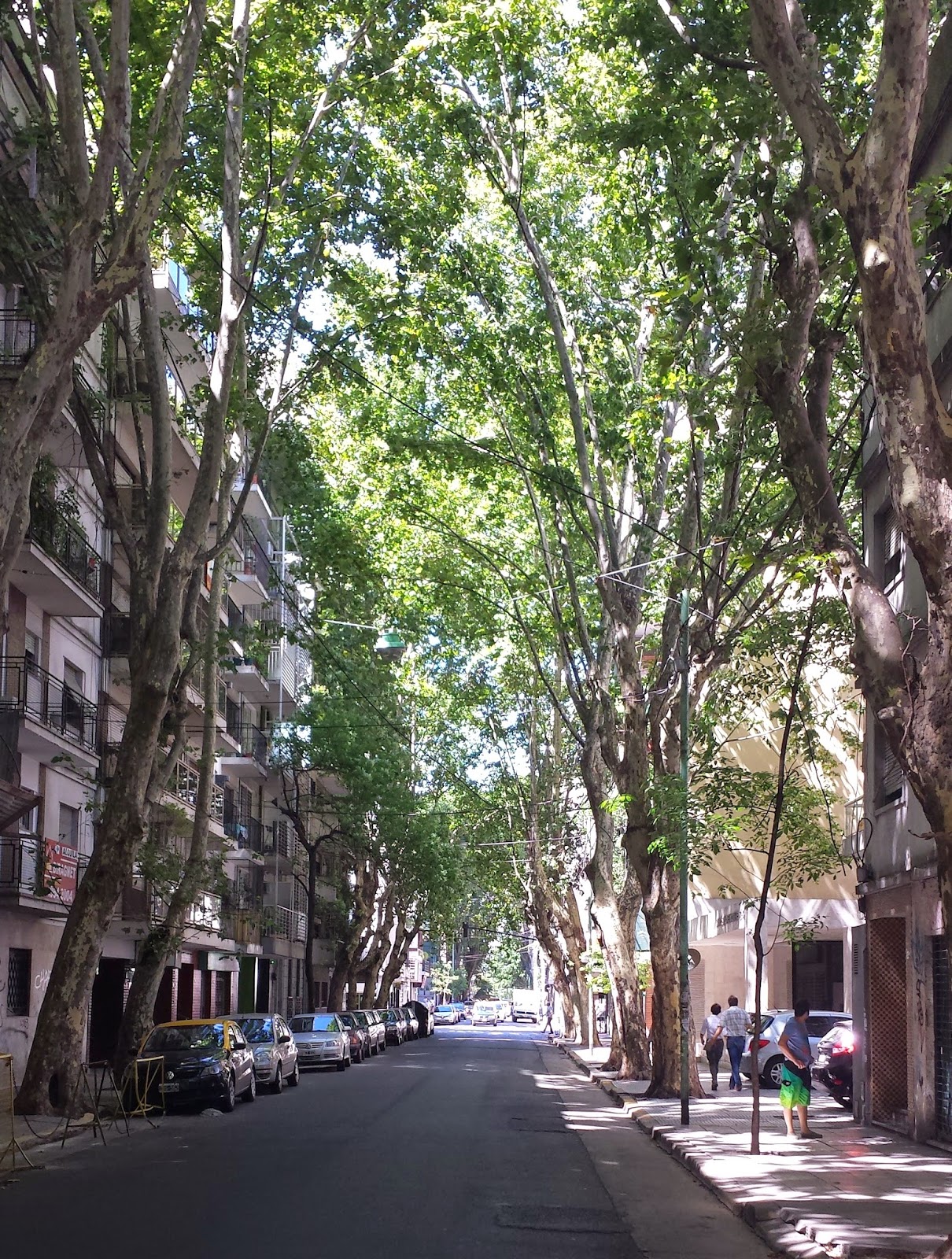We have been walking, walking, walking, and it has been hot,
hot, hot. We have a bit of a respite today, January 13, with cooling rain, but
it has put a damper (literally? What IS a damper anyway?) on our explorations.
Walking is our exercise and our main mode of transportation.
As we have gone about the business of getting settled in Buenos Aires (until
the end of February) we have walked through the city both knowing where we were
going (museums, synagogues, markets, etc.) and just to wander. In establishing
some basic amenities (getting a phone, finding our apartment, picking up money
transfers) we have spent hours getting nowhere (a familiar experience in Latin
America) which would be frustrating if we had any commitments to meet. Instead
we have just counted the steps toward our daily exercise goal and kept our eyes
and ears open for serendipity and inspiration.
Last Tuesday,
January 6, on our way to visit the Museo Nacional de Bellas Artes, as we were
walking along Avenida San Juan, I (Linda) saw two little signs placed in a
patch of earth along the sidewalk (which I photographed).
They read:
Remo Berardo
10-12-77
detenido desaparecido del barrio
durante (says one) por (says the other)
la dictadura militar
presente en nuestra memoria
Vecinos de San Christobal
24-03-04
My translation:
Remo Berardo
December 10, 1977
Detained
“disappeared” from the neighborhood
during (says one) by
(says the other)
the military
dictatorship
Present in our memory
The Neighbors of San
Christobal
March 24, 2004
We have
since seen markers similar to these in many places throughout the city. The
signs reminded me of the cobblestones I had recently seen in Eastern Europe,
with similar epitaphs, in front of homes where Jews had lived before being
taken to their deaths during World War II. Small reminders, easily passed by
and overlooked in a bustling metropolis, of a darker past and of the sorrow and
loss that persist.

Another
serendipitous find: on Jan 5, Shira and I (Jonathan) were walking near our
first apartment and came across a startling and moving mural painted on the
street-level wall of a factory. What first caught my eye was not the painting
but the words NES GADÓL HAIÁ SHAM
and UN
MILAGRO GRANDE HUBO ALLÍ (Hebrew and Spanish for “a great miracle happened there”)
flanked by drawings of a
chanukia (Chanukah menorah) on one side and a
dreidl on the other. The painting is of nine miners, each wearing a headlamp,
which form the lights of the menorah. I thought that it must be a reference to
the miners who were rescued from the mine collapse in Chile a few years ago.
The date on the mural was 2010, and when I got back I checked on line – the
miners were trapped from August to October 2010, so Chanukah that year was just
a few weeks later. I was incredibly moved to see this public tribute in such an
unexpected place.
* * * * * * * * * * * * * * * * * * * * * * *
 |
| San Telmo |
Our apartment is in San Telmo, which Lonely Planet
Argentina describes as “one of BA’s most attractive and historically rich
barrios [with]… narrow cobbled streets and low-story colonial housing…” Within
a few blocks are scores of bars, cafés, café-bars,
restaurants, small stores of every kind, galleries, bookstores, and more, with
residences at and above street level. There are chinos – small grocery
stores – and verdurderías – fruit and vegetable stalls – on just about
every block. It’s a mix of working-class, gentrified, run-down, and bohemian.
Our apartment is on the outskirts of the neighborhood and relatively
inexpensive.
Not far away is the riverside area of Puerto Madero, the river, and
beyond that, the Reserva Ecológica Costanera Sur, a large nature reserve where,
one of these days, we will go biking using Eco-Bici, Buenos Aires’ free bike
sharing program. Today we located a station just a couple of blocks from our
house.
 With Shira we have explored other neighborhoods and sampled many cafés
and a few bakeries. Mostly we eat meals in our apartment, with provisions from
the chino across the street and various neighborhood verdulerías.
We have made a couple of trips to Casa China, a large (though not by US
standards) Chinese market in Barrio Chino, which has lots of items we use in
bulk – dried beans, nuts, seeds, dried fruits, etc.
With Shira we have explored other neighborhoods and sampled many cafés
and a few bakeries. Mostly we eat meals in our apartment, with provisions from
the chino across the street and various neighborhood verdulerías.
We have made a couple of trips to Casa China, a large (though not by US
standards) Chinese market in Barrio Chino, which has lots of items we use in
bulk – dried beans, nuts, seeds, dried fruits, etc.

We spend quite a bit of time each day reading, writing (Jonathan), and
scribing/working on artwork (guess who). We have had dinner every evening with
Shira, and watch on-line videos together for a while. We give thanks every day – more than once
– that we are fortunate to be together, to be spending so much time with Shira
(more than we have since she went away to college), to be on sabbatical, and to
be in this place.




















